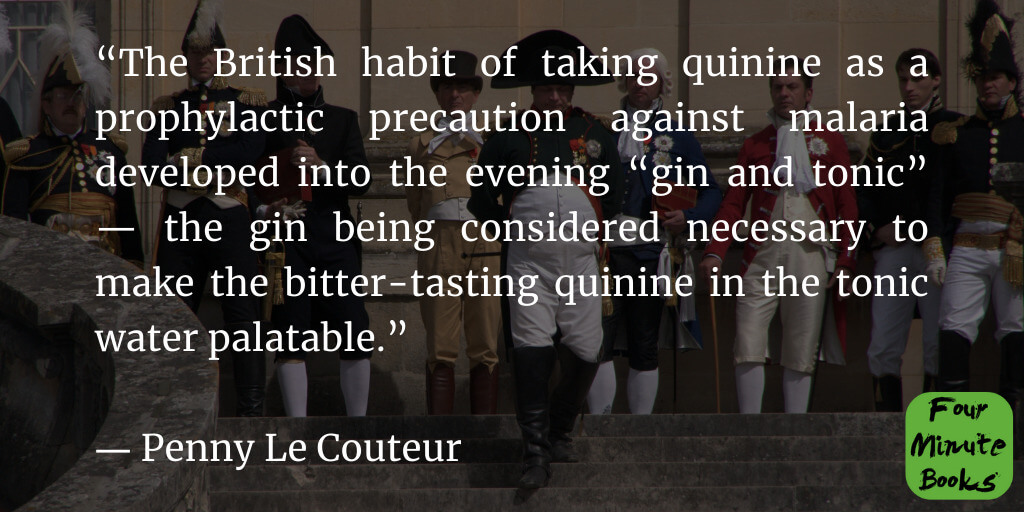1-Sentence-Summary: Napoleon’s Buttons explores the scientific phenomenon of molecules by highlighting how we can trace the origins of our entire existence to something as tiny as atoms and make sense of various events in history that shaped our world.
Read in: 3 minutes
Favorite quote from the author:

Have you ever thought about atoms? If you’re into science or you find biology interesting in any way, the answer is probably yes. But have you ever considered their impact on whatever it is that you did today? Probably not.
Napoleon’s Buttons explains the unlikely and surprising effects of molecular bonding on human history. From the formation of a molecule that led to the creation of a new country, to a molecule that helped end a war, we’ll explore how seemingly insignificant molecules can have an enormous impact on our lives.
Here are the top three lessons you should know from this book:
- Certain materials, spices, fabrics, and molecules changed the course of international history.
- Atomic changes happen when people make tiny mistakes in their chemistry experiments.
- We must first come to terms with the power of science in order to leverage it.
If you want to explore these lessons in detail, stick around and let’s delve into their backstory one by one!
Lesson 1: The atoms in molecules of fabrics and spices had a lot to do with Napoleon’s battles and Manhattan.
The story of Napoleon‘s disastrous Russian campaign is well-known. But what you might not know is that a little detail on the buttons of the soldiers in Napoleon’s army may have changed the course of history.
In fact, atoms had a lot to do with their loss. It seems that the French wore tin, which is a material that degrades in low temperatures. By the time the soldiers reached Borisov, half a million soldiers had turned into ten thousand men with the tin disease. What betrayed them were the atoms in their own clothes.
Take other examples from history, such as the expansion of the British Empire and cotton. In such high-humidity weather, the particles in cotton are linked well, as they thrive in that climate. Given how expensive it was and how much of it was produced, rainy Britain won a lot of the money that was used to build it.
And Manhattan? What’s that got to do with anything? Well, it seems that in the battle for nutmeg, which was thought to be a precious spice that cured diseases, what was once called New Amsterdam under a Dutch colony was given to the English in exchange for Run, an island where nutmeg was plenty.
Lesson 2: Accidental scientific experiments gave way for humanity to evolve and improve.
We owe a lot to the accidental scientific experiments of the past.
Take Flemming’s discovery of penicillin, for example. It was actually a failed experiment that accidentally led to the discovery of one of humanity’s most important medicines.
Similarly, William Perkin’s purple synthetic dye was discovered when he was trying to create a cure for malaria. When he discovered the purple dye stains, he contacted distributors. If he got it cheap, he could make a lot of money off of the dye.
Even Queen Victoria wore clothes dyed by his groundbreaking discovery, which says a lot about its potential. These are just two examples of how experimentation has helped advance humanity in many ways.
It just goes to show how chemistry plays such an important role in our daily lives and in the bigger picture as well. While we might not think about it, when you put everything together you can see how something as tiny as the right atom at the right time can change the world.
Lesson 3: Science is a powerful concept, which is why it took us as humans so long to come to terms with it.
Human beings have always been fascinated by the power of chemical reactions and biology. They’re what allows us to live, grow and change. And yet, we’ve only recently begun to understand them.
You’ve probably heard how in the past, women who used powerful homemade recipes and harnessed the power of plants were considered witches: they were using science to make things happen that had never happened before, and it scared people.
While religion has traditionally been the driving force in the world, we are quickly realizing science is quite powerful too — and that it offers us a better understanding of who we are as human beings.
To fully leverage the power of science, we must come to terms with its powerful implications. There’s no denial in the fact that random atoms change lives, that biology revolutionizes medicine, or that chemistry can make or break the world.
Napoleon’s Buttons Review
The Earth has been around for billions of years. Humans have only been around for a fraction of that time, but we’ve managed to make quite an impact on our planet.
We’ve developed technology that allows us to travel through space, build skyscrapers, and create new materials — but we’re still trying to understand the scientific force that’s driving our world.
Napoleon’s Buttons delves into the why and the how of atoms and molecules. The book addresses their implications and effects on the world and how they shaped history altogether, which is why it’s such an interesting read.
Who would I recommend Napoleon’s Buttons summary to?
The 15-year-old science geek, the 40-year-old chemistry professor who enjoys a good lecture, or the 30-year-old history enthusiast who loves to read about science and European history.
Last Updated on November 16, 2022